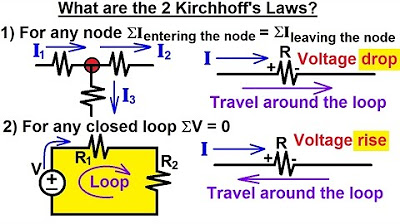Hukum Kirchhoff Rangkaian 2 Loop : [CARA CEPAT] - Listrik Dinamis Fisika Kelas 12 Part 2
Summary
TLDRThis video explains how to solve problems involving a two-loop circuit using Kirchhoff's laws. The presenter guides viewers through the process of applying Kirchhoff’s current and voltage laws to determine the current through resistors (I1, I2, I3) in a dynamic electrical circuit. With step-by-step instructions, including examples and a practical circuit problem, the video demonstrates how to approach such problems with system equations, solving for currents and potential differences. The viewer is also shown how to calculate power on resistors, with clear instructions on interpreting the results in the context of physics class 12 material.
Takeaways
- 😀 The video discusses how to solve dynamic Kirchhoff’s circuit problems for Class 12 Physics, specifically with two-loop circuits.
- 😀 Before diving into the main content, the video encourages viewers to subscribe for more updates on physics and mathematics topics.
- 😀 The Kirchhoff's Current Law (KCL) states that the sum of currents entering a junction equals the sum of currents leaving it.
- 😀 The Kirchhoff's Voltage Law (KVL) states that the sum of the potential differences around a closed loop equals zero.
- 😀 The video demonstrates a step-by-step method to solve two-loop circuit problems, including the identification of current directions and applying Kirchhoff's laws.
- 😀 Three main steps are highlighted for solving the problem: setting the direction of currents, applying KCL, and then applying KVL to both loops.
- 😀 The current equations derived from Kirchhoff’s laws in the example problem result in a system of linear equations with three variables (I1, I2, I3).
- 😀 The video walks through the process of solving the system of equations to find the values of currents (I1, I2, and I3) using algebraic steps.
- 😀 The video also explains how to determine the potential differences between points B, C, and D in the circuit after finding the currents.
- 😀 The power dissipated in resistor R1 is calculated using the formula P = I1^2 * R1, and the result in the example is 2 watts.
Q & A
What is the first step in solving a two-loop circuit problem using Kirchhoff's laws?
-The first step is to determine the direction of the current, for example, by setting the direction of currents I1 and I2 as entering point B, and I3 as exiting point B.
How does Kirchhoff's Current Law (KCL) apply to this two-loop circuit problem?
-According to Kirchhoff's Current Law, the sum of currents entering a branching point must equal the sum of currents exiting that point. In this case, I1 + I2 = I3 at point B.
What is the significance of Kirchhoff's Voltage Law (KVL) in this context?
-Kirchhoff's Voltage Law states that the sum of the potential differences (voltages) around any closed loop must equal zero. This helps to set up equations for the loops in the circuit.
What is the general strategy to solve for the currents in a two-loop circuit problem?
-The strategy involves five steps: 1) Determine the direction of current, 2) Determine the direction of the loop, 3) Apply Kirchhoff's Current Law, 4) Apply Kirchhoff's Voltage Law, and 5) Solve the system of linear equations.
How do we set up the first equation for Loop 1?
-In Loop 1, we apply Kirchhoff's Voltage Law by summing the EMFs and voltage drops around the loop. We use the direction of I1 to determine the signs of the EMFs and resistances, resulting in the equation -6 + 9 + 2I1 + 3I1 + 3I2 = 0.
How is the second equation derived for Loop 2?
-For Loop 2, Kirchhoff’s Voltage Law is applied in a counterclockwise direction. The EMFs and resistances are written with appropriate signs, resulting in the equation -12 + 9 + 6I2 + 3I1 + 3I2 = 0.
What does the negative sign in the value of I1 indicate?
-The negative sign in the value of I1 indicates that the actual direction of the current is opposite to the assumed direction in the circuit diagram, meaning I1 flows out of point B rather than into it.
How do you calculate the potential difference between points B and C (Vbc)?
-To calculate Vbc, you apply Kirchhoff’s Voltage Law along the path from point B to point C. Using the known values of currents and resistances, you find that Vbc = 8 volts.
How is the potential difference between points B and D (Vbd) calculated?
-To calculate Vbd, you consider the path from point B to point D and apply Kirchhoff’s Voltage Law. After calculating the contributions from the EMFs and resistances, you determine that Vbd = 8 volts.
How do you calculate the power on resistor R1?
-The power on resistor R1 is calculated using the formula P = I1^2 * R1. Given I1 = -1 A and R1 = 2 ohms, the power is P = 1^2 * 2 = 2 watts.
Outlines

Этот раздел доступен только подписчикам платных тарифов. Пожалуйста, перейдите на платный тариф для доступа.
Перейти на платный тарифMindmap

Этот раздел доступен только подписчикам платных тарифов. Пожалуйста, перейдите на платный тариф для доступа.
Перейти на платный тарифKeywords

Этот раздел доступен только подписчикам платных тарифов. Пожалуйста, перейдите на платный тариф для доступа.
Перейти на платный тарифHighlights

Этот раздел доступен только подписчикам платных тарифов. Пожалуйста, перейдите на платный тариф для доступа.
Перейти на платный тарифTranscripts

Этот раздел доступен только подписчикам платных тарифов. Пожалуйста, перейдите на платный тариф для доступа.
Перейти на платный тарифПосмотреть больше похожих видео
5.0 / 5 (0 votes)






